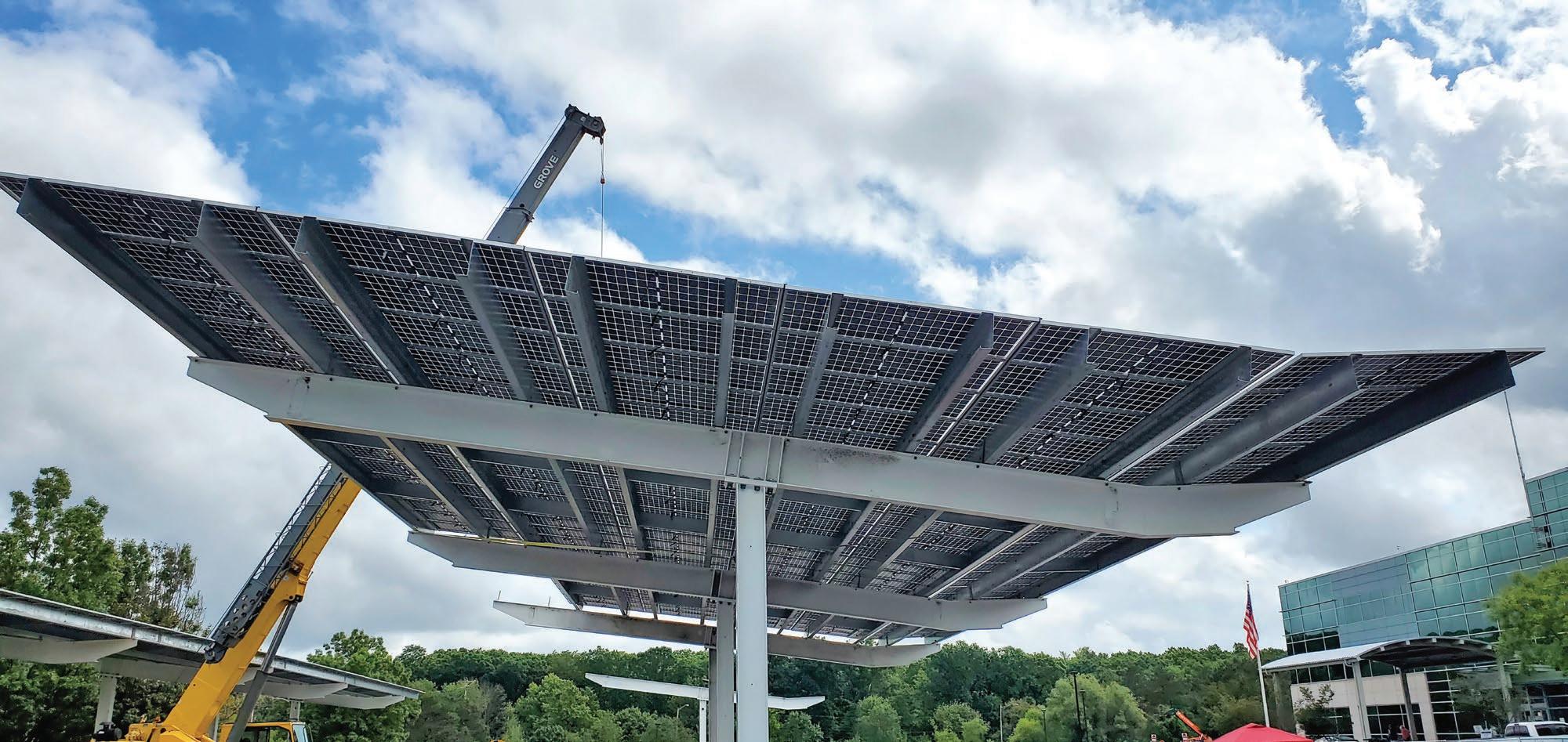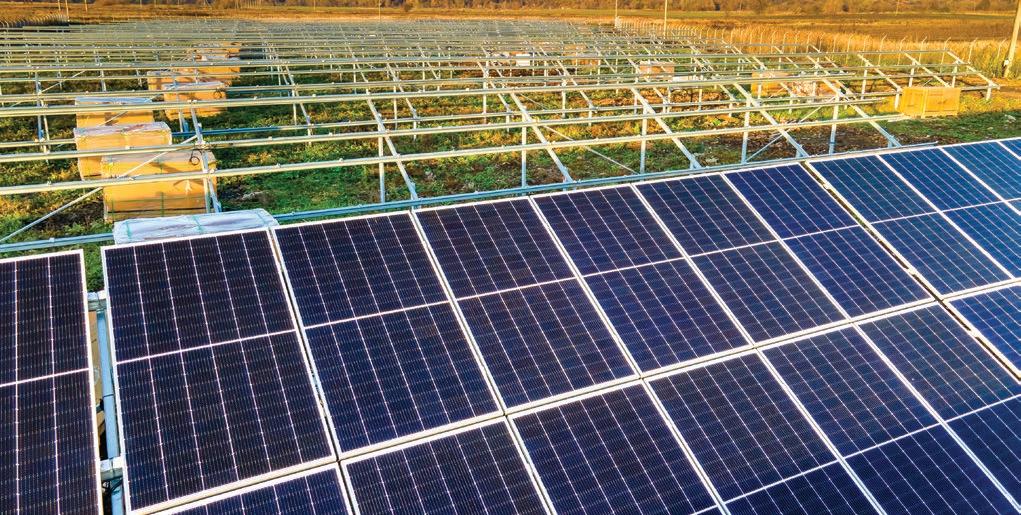
5 minute read
Project Completion Insurance: Securing solar construction projects
Project Completion Insurance
Securing solar construction projects
by Isaac Stern and Gage Kellogg
Construction of renewable energy and storage projects have gained significant momentum in response to the global shift toward sustainability. All types of investors, borrowers, and lenders are diving into this booming sector, but they are also navigating a complex landscape of risks and uncertainties. In this dynamic environment, Project Completion Insurance (“PCI”) has emerged as a powerful tool, offering an array of benefits to lenders and borrowers alike.

Understanding Project Completion Insurance
In today's economic climate — characterized by rising interest rates, material prices, supply chain disruptions, and construction labor shortages — the risks associated with solar projects are heightened. Construction loans inherently carry higher interest rates due to the multifaceted risks they entail. Challenges like schedule delays result in extended general conditions costs, material scarcities lead to higher prices, and fierce competition for a limited labor force translates into elevated wages to attract and retain skilled workers. These risks can cause significant financial strain to all of the project’s stakeholders.
PCI is an innovative insurance product (underwritten by Lloyd’s of London) that provides financial protection to cover cost overruns beyond the original budget in the event of borrower default. PCI was created to provide financial backing as an add-on to a comprehensive construction risk management services program. These services encompass crucial aspects such as independent engineering and contractor due diligence before loan closing, construction monitoring and funds control after loan closing, and professional project management services in the event of a general contractor default. Many solar construction projects already require one or more of these risk management services; when PCI is used as an add-on, it seamlessly provides an additional layer of financial protection to a lender's risk management portfolio while proactively derisking construction projects.
Lender benefits
PCI is a robust tool that offers several compelling benefits to solar lenders. Firstly, it uniquely positions the lender as the direct beneficiary of the policy, a departure from traditional surety bonds where borrowers are the direct beneficiary. This direct arrangement streamlines the process, enabling lenders to promptly address project failures and help eliminate the need for protracted litigation often associated with bond claims. Additionally, PCI simplifies the ease and speed of activation. Compared to traditional surety bonds, PCI is far more accessible and straightforward to invoke by lenders, ensuring swift funding of cost overruns when needed due to borrower default. In the event of a project's failure, lenders can promptly call upon the insurance to fund cost overruns, minimizing disruption, project delays, and financial strain. Lenders can efficiently resolve issues and remove troubled loans from their books, which ultimately bolsters their financial health.
PCI also serves as a valuable credit enhancement tool that allows lenders to support borrowers with diverse credit profiles, or borrowers who are also the contractor and do not qualify for traditional surety bonds. However, unlike surety bonds, PCI is typically more cost-effective since it is coupled with construction risk management measures that proactively reduce the likelihood of financial setbacks and/or delays, and ensures subcontractors remain on the job even in cases of general contractor failure.

Borrower benefits
In today's construction landscape, borrowers face increased scrutiny due to the uncertainties inherent in solar construction projects. Factors like rising interest rates and inflation have made all parties more cautious about entering into construction loans. However, by using PCI as a credit enhancement, PCI can help borrowers navigate these challenges and open doors in instances where they may not have met traditional lender criteria. In addition to being a proactive credit enhancement tool, borrowers may be able to use PCI to negotiate more favorable loan terms and conditions. Plus, it is often used as a bond alternative for borrowers who self-perform construction and do not qualify to be bonded in this borrower/ builder arrangement. In contrast to traditional credit enhancement options such as surety bonds, PCI is also typically more cost-effective, and doesn’t rely on the balance sheet of the borrower/builder to obtain coverage. This cost advantage enables borrower/builders and EPC contractors (Engineering, Procurement, and Construction) to allocate their financial resources more efficiently, ultimately reducing the overall expense of their solar construction projects.
Choosing the right credit enhancement
The appeal of credit enhancements is that they benefit all project stakeholders, so selecting the appropriate one(s) is a critical decision in any solar project. It can make the difference between securing financing and facing rejection. Each credit enhancement option has its advantages and disadvantages, and the choice should align with the specific needs of the project and the risk tolerance of the parties involved.
Surety and P&P bonds, for example, are good for public projects, but can be slow and challenging to claim, and lead to costly litigation. Other traditional options include letters of credit, additional guarantors, and restricted cash. Letters of credit provide access to cash, but can be expensive and restrictive. Adding guarantors improves credit, but can be challenging and costly for the borrower. While restricted cash ensures loan repayment, it ties up the borrower's working capital, which can potentially hinder their capacity to undertake new projects.
PCI has become a valuable tool in the world of renewable energy and storage construction projects. Its ability to mitigate risks, enhance financial security, and foster confidence among stakeholders makes it a game-changer that offers a path to a more secure future for these projects. Although PCI serves as a highly effective standalone tool for mitigating risks and ensuring successful renewable energy construction project completion, it can also be seamlessly integrated with other credit enhancement options, providing an extra layer of protection and flexibility to address the various challenges that may arise during the project lifecycle.
Isaac Stern is Executive Director for SureBuild Project Completion Insurance | Saint Vincent.
Gage Kellogg is Managing Director, Renewable Energy Services at Partner Engineering and Science, Inc.




